
Thursday, January 28, 2016
Harira
This one has Moroccan leanings, but makes me think of the American Southwest as well. It involves — beyond the dried chickpeas — lentils, vegetable or chicken stock, a can of tomatoes, some broken dry pasta, a chopped onion, cilantro, parsley, and a ribbon celery finely chopped; and it’s flavored additionally with butter, turmeric, black pepper, and cinnamon. It was delicious tonight, and I bet it’ll be even better tomorrow.
Green salad, of course; a bit of chocolate for dessert.
Family table

My son and I ate exactly the same: half a dozen oysters on the half shell; braised pork shoulder with new potatoes, sweet-sour red cabbage, mustard, and sage. A good country plat principal ; a celebratory entrée. Dessert: apple galette with rum-raisin ice cream. Yes.
• Café Chez Panisse, 1517 Shattuck Avenue, Berkeley; 510.548.5525
Oh: and before dinner, a delicious house Old Fashioned next door:
• César, 1515 Shattuck Avenue, Berkeley; 510.883.0222
☛Restaurants visited in the last year are listed at Eatingday's Restaurants
Monday, January 25, 2016
How I Write Certain of My Blogs

Last week, on the other hand, on a quick road trip to Los Angeles and Reno, I gained four pounds. We have not been fasting on Tuesdays as is our usual wont (nor will we tomorrow; that will have to be put off yet another day). Nor have we been walking, much.
So these last couple of days we've taken it easy. Saturday we had a delicious posole of sorts at home: hominy, made quite spicy. And yesterday we made due, after our usual weekday breakfast of cappuccinos and a slice of buttered toast, with the hash and eggs you see here, made with corned beef brisket and served with potatoes and kale, taken with a Bloody Mary at the club a friend belongs to.
BUT I WANT TO WRITE a response here to a thoughtful question/comment posted by a reader today:
As I think I've mentioned here before, I perceive a disconnect between the experiences you describe here at Chez Panisse--to which you have clear links--some family, some probably financial--and those you describe at other "eateries."The comment was triggered by the recent post here on a couple of dinners at Chez Panisse, in the course of which I thought I made clear my connection to the restaurant.Chez Panisse is among the most ambitious of high end restaurants. There's really no way around admitting this, given its high prices, and the stream of books and "publicity" which emanate from the operation. It is routinely measured against the most ambitious restaurants locally, regionally and around the world. This means it is under constant scrutiny.
As one of its regular diners, you're in a position to engage in such comparisons.
In your "eating every day" blog, you focus attention not only on Chez Panisse, but you conduct an astonishing full-time survey of eateries both in the U.S. and abroad, though it doesn't seem systematic. It seems to be part of a campaign of constant (restless?) travel, taking notes, recording ingredients and accompanying wines. If this doesn't have an ulterior purpose, it must qualify as an obsession.
What often puzzles me, is that though you constantly return to Chez Panisse as a kind of measure of what you seek, you don't seem to sample the higher end competitors of your "harbor" operation. It may of course be that you do, but you don't talk about those instances. As nearly as I can tell--and I'm willing to be enlightened here--you spend most of your time at smaller, less pretentious places, whose lower prices and less ambitious goals allow for the occasional surprising experience; many of the qualities and characteristics of good dining are not about pretense and ambition, but about a love of ingredients and simplicity--the very qualities which Alice Waters and her staffs have striven to promote over the years.
Whether this disconnect is as apparent to others, as it is to me, I can't say. Since you almost never address the question here, I suppose for reasons related to privacy, it leaves the reader of your blog wondering what the underlying agenda of your campaign is--if indeed it does have one over-riding purpose. You have no obligation to address this question, if you choose, but it's one that--for me, at least--constantly hangs in the air. Your "100 plates" for instance--which I can't recall ever having seen printed out--might provide a canonical framework upon which your personal gastronomic philosophy could be displayed. Is there a tacit connection between the underlying rigor of Chez Panisse and the 100 plates?
All of which is offered in the spirit of innocent curiosity!
It gives me an opportunity, in the first month of the new year, again to set out the nature — I won't say "assumptions," or "agenda" — of this blog.
Eating Every Day is basically an online log, written as a personal journal, noting nearly all our dining — snacks, breakfasts, and lunches generally excluded. It is, for me — (and it is for me) — a springboard for musing on cuisine, which I think a basic, perhaps the basic foundation of culture. If it is helpful to others, as a guide to eateries, and to dishes, that's fine; I won't say I don't also have that in mind.
But it is not meant to review eateries. I do write occasional reviews on Yelp, Trip Advisor, and the like; but I do that rarely. I am of course a critic, a retired music and art critic, and I took that profession fairly seriously. I always like to think of criticism as it is defined by Joseph Kerman: "the study of the meaning and the value of art works." (Joseph Kerman: Contemplating Music: challenges to musicology, Harvard University Press, 1986.) Notice he doesn't equate criticism with evaluation: rather, with the study of value.
I prefer to write, especially on this blog, positively, not negatively.
Now to some of the comment's points: We rarely dine in high-end restaurants, even those owned and operated by friends, even those you might call Chez Panisse spinoffs — owned and operated by people who've been Chez P mainstays, and gone on to their own restaurants. (There are many of these: off the top of my head, Quince in San Francisco; Pizzaiolo and Camino in Berkeley…)
I try always to identify such people — Kees at Worst and Marius in Amsterdam is an example — as friends, and the reader should infer that I will not publicly criticize a friend: if I write about him and his work, as I have in the case of Kees (sorry about that) and Sander, also in Amsterdam, it is because I have no fault to find, only enthusiasm, which I want to share.
I think the commenter is correct: there is no system to this survey at Eating Every Day; it is the result of an obsession with travel, with taking note (though too rarely with taking notes!), with recording experience.
We do in fact "spend most of [my] time at smaller, less pretentious places, whose lower prices and less ambitious goals allow for the occasional surprising experience; many of the qualities and characteristics of good dining are not about pretense and ambition, but about a love of ingredients and simplicity…“
And the idea of the Hundred Plates, like that of the Hundred Restaurants, is indeed directed to that principle.
Though I will note my distaste for the word "pretentious." It is not a synonym for "ambitious," and should not be so used. It's a very serious charge, though used casually and lightly.
And at some point in the future I'll try to prepare notes on other ambitious restaurants, and perhaps try to compare their costs. I note, though, that I never mention costs or prices here, for a few general reasons — which belong more to a discussion over at The Eastside View than here.
A final note: This blog receives few comments; I'm not sure why. I think I have never failed to clear them for posting. I have written 2,318 posts to the blog, beginning in March 2008. There have been 173,44 page views over those years. The blog has thirty "followers," whatever that means. As of this morning there had been 43 views today; there were 85 yesterday; over three thousand last month.
There have been 298 viewers in the United States, 22 in Germany, 19 in Russia, 17 in Netherlands, 12 in Italy, 9 in the UK, 8 in Spain, 7 in Poland, 6 in Ireland, 5 in Australia. I suspect most of these people are either friends, family, or colleagues in the restaurant business.
And very few of them, virtually none of them, leave comments. I'm used to this: as a journalist on a daily newspaper, over the course of fifteen years or so, I received only a handful of letters. People don't write, in general; only we obsessed do…
And I close with a quote I posted to Facebook yesterday, from the novel Hour of the Star by Clarice Lispector:
☛Restaurants visited in the last year are listed at Eatingday's Restaurants
Saturday, January 23, 2016
Pilaf

She does make a barley pilaf now and then, almost always with scallions in it — it's a favored standby here. But tonight's pilaf is made with wheat.
And not just any wheat: this is wheat from our friend Lou Preston, who has been diversifying over the years away from grapes and wine, though he still produces a fine line of wines from his Dry Creek Valley farm. He's branched out: olives, vegetables, and more recently wheat, inspired by his love of baking — his bread's one of the best I know.
We bought this wheat over a year ago; we should have eaten it by now. I bought it for breakfast, because I do like to make bogman cereal when the weather's cold. We keep the grain in an enamelled tin box in the refrigerator, and so far haven't had trouble with it turning rancid.
I didn't watch, so I'm not sure how Cook handled this pilaf. I know it involved mushrooms, that was obvious; and she undobtedly started out with a soffrito of onions, and I saw her get some turkey stock out of the freezer, a souvenir of the Thanskgiving bird no doubt. I would have made this exactly as I do risotto: soffrito; then fry the grain; then slowly add stock and keep it simmering until done. Oh yes: the mushrooms. I'd have cooked those separately, in olive oil, and added them to the cooked pilaf.
Green salad; vanilla ice cream with applesauce. Good dinner, Cook!
Friday, January 22, 2016
Reno

We chose a familiar place for dinner last night, though, because we remembered eating well there ten years ago. Natalie Sellers, the chef-proprietor, definitely has both chops and discrimination, having done her time in the San Francisco Bay area — with Jeremiah Tower at the old Stars, among other assignments.
I had the roast pork tenderloin you see here: pork from Niman Ranch, brined before roasting, cooked to just the right degree, and served with carrots and apples, mashed potatoes, and a nice green tomato chutney. No gloppy gravy; just the clean flavors of the main ingredients.
Dessert was a very nice fig cake, moist and nutty, with a well calculated cream-cheese royal icing that didn't dominate the dish, and a nice, smooth vanilla ice cream. Yes; we'll go back here…
with the dessert, a nice Oloroso
LUNCH TODAY was in another familiar setting, a soup-sandwich-pasta breakfast-lunch-and-dinner spot popular with the locals. Here, though it was noon and lunchtime, facing the long drive home, I fortified myself with steak and eggs — a small New York steak, tender and decently flavored, and two eggs over easy. With hash browns, of course.
• 4th Street Bistro, 3065 W 4th St, Reno; (775) 323-3200
• Stone House Cafe, 1907 S Arlington Ave, Reno; (775) 284-3895
☛Restaurants visited in the last year are listed at Eatingday's Restaurants
Tuesday, January 19, 2016
Lone PIne
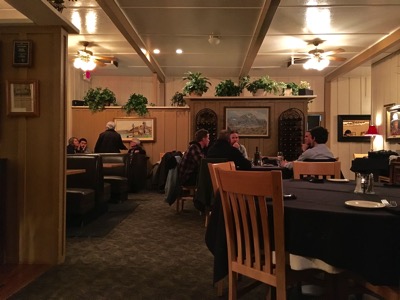
But dinner was okay, partly because we were hungry and had driven hours, through twilight and then dark night, desert and mountains on either side of a two-lane road through unseen empty landscape. But beautiful.
I had a filet mignon with Béarnaise sauce, nicely flavored with tarragon but a bit too gloppy, the steak done just to my preference (rare), the few slices of carrot unobjectionable, the garlic mashed potatoes too salty and too suspiciously laced with garlic salt rather than true garlic.
The Martini (Gordon's; unspecified Vermouth but, as I'd asked, present; lemon twist rather than olives; up) was the best I've had in a number of weeks. Well, days.
The host, then the drink-bearer, then the busser; and the waitress, were both quite engaging and pleasant.
The guys at the next table were all speaking French. We asked our waitress about this. Turned out they work at the water-bottling plant nearby. Ah, globalism.
☛Restaurants visited in the last year are listed at Eatingday's Restaurants
Monday, January 18, 2016
Gjelina
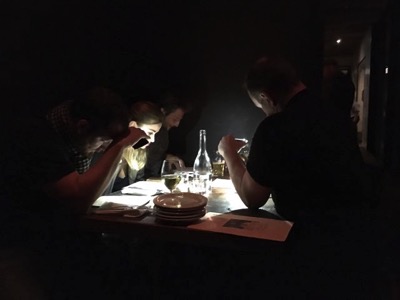
The menu, on a single sheet of paper, brasserie-style, is interesting: but I confess I'll have to examine it more closely tomorrow. (I photographed it, as I generally do, for later study — but, tonight, also, in order to read it in the dark.)
It's Monday night, but it's also the last day of a three-day weekend. And we're eating late, at nine o'clock. We were shown to a promising little side room, only four tables, a young romantic couple the only other diners, and we thought for a while we'd be able to converse. But then three men sat down at the next table, soon joined by another couple; they conversed at full volume, so loud I couldn't tell whether in Russian, Bulgarian, or maybe even Hungarian.
Oh well: let's make the best of it, and turn back to the menu. Everything's à la carte, and this is what we ordered:
Vegetable: Roasted romanesco, anchovy, Fresno chili, white wine & garlic
Small Plates: Grilled wild boar sausage, sauerkraut, red onion, thyme & Dijon mustard
Pasta & fagioli soup, mint pesto, black pepper & olive oil
 The salad was truly delicious, the greens in just the right balance, the shallot adding a bit of texture and sweetness. There was a bit of sand in the greens, I thought, but otherwise a very nice salad indeed.
The salad was truly delicious, the greens in just the right balance, the shallot adding a bit of texture and sweetness. There was a bit of sand in the greens, I thought, but otherwise a very nice salad indeed.
The romanesco was truly roasted, probably in a wood-burning oven, and it arrived on a plate on top of a generous spread of what I would call bagna cauda: anchovy dissolved in garlic-flavored olive oil. This was a delicious dish.
The Contessa's wild boar sausage — just how "wild" is the animal, I wonder — the sausage, though, was very nicely made, plenty of spice to offset what might otherwise be a heavy meat, bound with just a bit of other material of some kind, cased, then grilled, and served with a sweet, rather delicate sauerkraut, probably made in house.
 I liked my soup, but I'd have called it minestrone, not pasta e fagioli. True, beans and pasta were involved: but so were a number of vegetables,
including carrots and potatoes. I liked the minty pesto, a good garnish.
I liked my soup, but I'd have called it minestrone, not pasta e fagioli. True, beans and pasta were involved: but so were a number of vegetables,
including carrots and potatoes. I liked the minty pesto, a good garnish.
Dessert: my Contessa ordered a gelato, as she often does. There were two on offer: stracciatella and "amaretti". She took the latter: but there was no hint of amaretto in the flavor, which was far too salty. My butterscotch pot de crème, though, was a real pleasure. It too involved salt — salt caramel — but it was controlled, and further moderated by crème fraîche, and I enjoyed every bit of it.
Barbera d'Alba, Camerano, 2012: very true to varietal and place, sound, good flavor and finish
☛Restaurants visited in the last year are listed at Eatingday's Restaurants
Sunday, January 17, 2016
Jérôme's final day
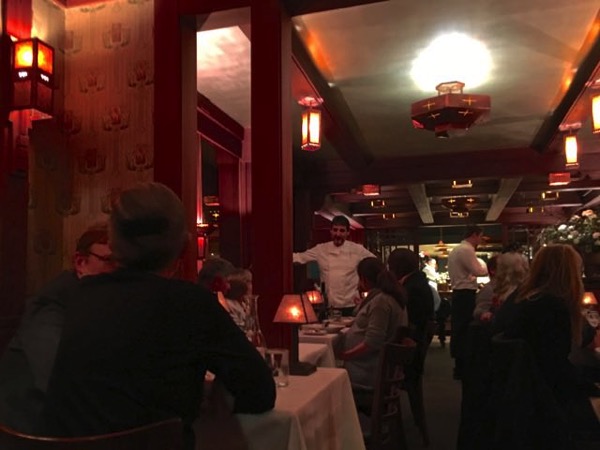
 |
| Endive, roe, chives |
 |
| Striped bass and sea scallop |
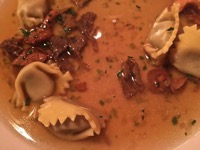 |
| Agnolotti in brodo |
 |
| Quail vigneronne |
 |
| Meringata |
The wine does not taste at all like a typical Vermentino; it's spent time on the lees, with an almost Sherry-like result — lending further structure to the delicate salad.
The Riesling surprised me with its own delicacy; it might have been better to reverse its position with the preceding Vermentino.
Nebbiolo was a fitting choice to complement this complex meat course, and this bottle was characteristic and mature.
It's so interesting to think of this meal in the context of the previous night's. Many similarities: fish, fowl, the Italian influences — but very different experiences, like feminine-masculine, or Torino-Firenze. These dinners seems to me to prove the capability cuisine has of achieving a truly artistic level, combining deep appreciation of the media, intelligent awareness of history, and imaginative vision of possibilities. Sitting at this table you can't help become more appreciative, more thoughtful, above all grateful to those who have brought it to this degree of perfection…
• Chez Panisse, 1517 Shattuck Avenue, Berkeley; 510-548-5525
☛Restaurants visited in the last year are listed at Eatingday's Restaurants
Chez Panisse

The fact, and the history of the fact, have been disclosed publicly for many years, most clearly I think in the book Alice Waters and Chez Panisse by Thomas McNamee, who became a personal friend during the interviews he conducted in the course of writing the book.
So much for dispelling any thoughts of bias through personal involvement.
Let me add quickly that my principal association with the restaurant, over nearly thirty years from its opening, in 1971, was the fact of my companion's role on its staff as pastry chef. My own involvement has been less hands-on; I am by no means a culinary professional. (Though like most middle-class and lower-middle-class Americans my employment history has included a number of eateries.)
Chez Panisse is justly considered an epochal restaurant, and our fascination with the institution has gone beyond the pleasures of the table throughout its long history. The kitchen, sure; beyond that, the business, as an exception to for-profit motivation;, as a family of staff, associates, and diners; as a moment (and a movement) in cultural history. I know: all this can sound quite pretentious. Believe me: none of it was every really intended. It's all been lucky accident, born of the intersection of time (the 1960s), place (Berkeley, California), the pursuit of pleasure, and an intense commitment to ethics. Occasionally, in the course of history, idealism pays off.
Okay: Friday night we dined downstairs at Chez Panisse, as we did again last night, on a bittersweet occasion: these were the final two dinners under the supervision of chef Jérôme Waag. I set his name with diacriticals because Jérôme is French, one of a number of influences on his gifts as a chef. Among others: He's an artist, long involved with sculpture and performance art; he's intelligent; he's open-minded yet focussed and methodical; he's been in the Chez Panisse kitchen for much of his adult life. He has worked with virtually every chef in the Chez Panisse history: among them Jean-Pierre Moullé, Paul Bertolli, Catherine Brandel, David Tanis…
For two years he's alternated downstairs with Cal Peternell — downstairs chefs have been co-chefs for many years now. And now he's leaving, for the most honorable of reasons, to develop his own restaurant. Unfortunately for some of us, it will be in Japan.
His place will be taken seamlessly; the restaurant is very long on its own persona. Over the years there's no doubt most chefs have influenced one or another strand of the complex character of the cuisine, but the core, for decades, has developed a lasting strength of its own — largely no doubt because of the steady guiding hand and critical eye and palate of Alice Waters, who is of course the chef.
FRIDAY NIGHT'S MENU, though, seemed to me distinctly Jérôme, for all that each course was in fact executed, as always, by a different cook on his team. And here is what it was:
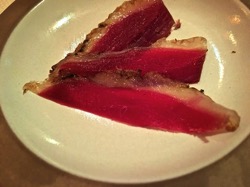

 |
| chicories, beets, roe |
 |
| striped bass, fennel purée |
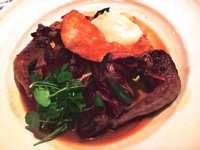 |
| squab, parsnip purée |
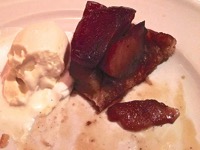 |
| Tarte Tatin |
Yes, beets again. Sliced thin, though, and cooked so crisp that they'd lost all that aluminum-foil flavor and granular-mushy texture they all too often have. The chicories — we used to call this Belgian endive, no? — were tender and full of flavor, and the creme fraiche and roe made a marvelous play on the more usual vinaigrette. What a salad!
The wine was soft but substantial, with the flavor and aroma of a Chablis but not the flinty edge: a fine complement to the salad.
To me distinctly a Japanese-influenced dish: lots of umami. The firm fish, soft purée, and supple olive oil contrasted wonderfully with one another, and somehow the flavor of the purée, though quite delicate, easily held its own with the sweet, fresh bass. I think the coriander, chopped and sprinkled on top of the fish, may have facilitated the combination of tastes.
The wine was interesting: a varietal new to me, fermented and aged with a sherry-like overtone of flor, that fine yeast you sometimes see layered on the surface of wine still in the barrel. I suspect this wine is left on the lees, not fined or filtered before it is bottled.
The Gigondas — a very fine wine, carefully made, mostly Grenache (80%) but with Syrah, Cinsault, and Clairette as well — a careful blend making the most of its ingredients, and ending with the integrity and balance you expect from a Bordeaux, even.
Tarte Tatin used to be such a simple matter: the right apple, cut into chunks the right size, set in butter and suger in the pan, then baked under its pastry. It's a country dessert, and as if in mistrust it has grown, over the years, to be treated with disrespect, robbed of its bittersweet caramel, garnished with strawberries or citrus, smothered under cream or, worse, aerosol whipped cream. Not here: the fruit combined completely with the caramel, and the ice cream with its silky texture remained a thing apart, a companion, not a modifier.
The Jurançon clearly thinks of Sauternes without regret. I like it; I would need to get to know it better to take it on its own terms.
THEN LAST NIGHT, Saturday, we returned for Jérôme's final evening. That dinner, though, will have to wait for my next post…
• Chez Panisse, 1517 Shattuck Avenue, Berkeley; 510.548.5525
☛Restaurants visited in the last year are listed at Eatingday's Restaurants
Friday, January 15, 2016
Pasta

I could type "pasta" into the little search box above and to the left, I suppose, and find out how many posts here have mentioned it: but I'm not online as I write this, and here on Eastside Road our connection is ungenerous. Try it yourself if you like.
We routinely eat a lot of pasta: the last few weeks have been unusual in its paucity. We did very much enjoy the puttanesca a friend made in Voorburg, though, and last night Cook whipped up a batch to feed a guest. We don't have it often enough, in my opinion. Tomato sauce, onion and garlic, capers and olives — it's hearty and warming on these cold winter nights.
And it keeps: here you see it the second day. Fusilli are a perfect shape for it, the screw-shape threads holding the sauce well. Tonight was our third pasta this week; we're making up for lost time — Monday night, after the long flight from Stockholm, we stopped in Berkeley for fettuccine. Tuesday, of course, was a fast day. And tomorrow and Saturday — well, they will be special days, I promise you…
☛Restaurants visited in the last year are listed at Eatingday's Restaurants
Sunday, January 10, 2016
Authentic Swedish

It was printed on a single sheet, old-time brasserie style, and in fact the open plan, the dark panelling on the walls, the restricted menu all suggested that was what we were going to deal with: another brasserie. Which is always fine with me.
We began with a very nice little mixed salad: red pepper, cherry tomato, iceberg lettuce, cucumber, a little onion, all in a cider-vinegary vinaigrette. Very nice.
My companion went on to meatballs; I couldn't resist the tartare. It arrived in a version perfectly traditional but for one thing: a couple of spoonfuls of diced beets. I quickly ate them first, lest they contaminate the rest of the plate, and then mixed up the rest of my plate with knife and fork: chopped raw beef; an egg yolk; capers; shallots; chives; mustard; horseradish; salt and pepper.

It was a delicious tartare. The beef was sweet and not super-tender; it had what the critics call a great mouth-feel, substantial and lasting. The condiments also had good flavor — well, not the beets, but they were by now hors de combat. The host admitted that tartare might not be an authentically Swedish dish, you find it everywhere, but it is very popular in Sweden, so perhaps we can let that stand.
Côtes du Rhône, Bonpas, Don Alfant, nv
☛Restaurants visited in 2015 are listed at Eatingday's Restaurants
Saturday, January 9, 2016
Authentic; global

And the clientele, outside of the Contessa and I, couldn't have seemed more Swedish. Blonde or dark-haired, they could step out of Central Casting or an Anders Zorn portrait. Many tables were occupied by groups of four, five, or six men, little glasses of snaps and big ones of beer at their elbows; others hosted families, some with small children. It's Saturday noon, time to be out on the town.
We'd done our shopping and visited the impressive public library and were now hungry. The brasserie-style menu offered a lot, but we took the least imaginative: moules marinière for Companion; meatballs for me.
First thing set down on the table was a double dish containing lingonberry preserves on one side, sliced cucumber pickles on the other. Promising. Soon after came an absolutely classic French-style marinière, the tiniest mussels we've ever seen in a rich, creamy, slightly tarragon-scented broth; and my plate.
Classic: nothing but seven or eight savory meat balls, speaking of veal and beef, cloves and cinnamon, care and tradition; the smoothest imaginable potato purée; and a thick brown gravy.
I added the lingonberries, of course, and the pickles. Before long I found it was best to mix them all up — on the fork, not the plate. Afterward, a very tart, very smooth lemon sorbet cleansed the cavities. It was truly a delicious lunch.

DINNER WAS QUITE another matter. We weren't terribly hungry, of course; and we were a little tired; and we didn't feel like leaving our hotel, in the suburbs, to investigate the icy dark streets. So we ate in an inexpensive hotel's own restaurant.
I could have been worse: but, as I said to Companion, the quality of commercial hotel-style cooking in Sweden seems not to have advanced beyond what The Netherlands had left behind in the 1970s.
I ordered the daily special: "John Stone" entrecôte. Mr. Stone turns out to be an Irish producer of grass-fed, sustainably raised beef, and the meat was in fact quite nice: very tender, and with a flavor reminding me of the génisse we used to eat when I was a boy, the flesh of superannuated milk cows. It doesn't sound appealing, I know, and I suppose it's an acquired taste: but I had no choice but to acquire it.
The steak was cooked medium rare and had a lot of flavor. The sauce was very rich, with perhaps a hint of the Maggi cube, and I wasn't excited by the deep-fried sweet potatoes, but what can you do. It could have been worse.
☛Restaurants visited in 2015 are listed at Eatingday's Restaurants
Worst

I haven't given Worst credit here, partly because I rarely write about lunches: dinner has a way of shouldering other items aside. (I've been remiss, for example, at not mentioning bakeries, and cafés, and poffertjeskramen.)
Worst — the word is Dutch for "sausage," and was applied to this restaurant with a deliberate sense of humor, intending it to be the Worst restaurant in Amsterdam — Worst is the sidekick to Marius, the restaurant we've dined at twice in the last few days. The owner-chef was greatly influenced by Chez Panisse in Berkeley, where he worked a couple of years; Worst is in a sense to the Café Chez Panisse what Marius is to the downstairs restaurant.
But only in a sense, for Worst is not a café, or a bistro, or a brasserie; Worst is a wine bar. I'm never sure exactly what a wine bar is, for I never go to them. Wine to me is something to have with dinner (or, now and then, lunch); it's a food; and it's not to be sampled with three or four other wines, unless in fact a tasting is going on, which is a very different matter, having nothing to do with Eating.
One of the things that makes it a Wine Bar, I guess, is the seating: very casual, on stools, at tables big enough to require sitting with strangers when it's busy. Another is the menu, which is quite restricted and, I think, fairly unchanging. A third, of course, is the very extensive wine list.
But we've taken lunch here two or three times in the last few days, partly because it's close to our apartment, partly because we do love Kees, partly or mostly because it's really good.
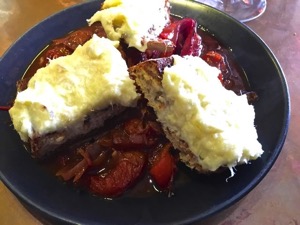
Today I had baccalà. Steady readers know my fondness for salt cod. This was an excellent baccalà, with a beautiful smooth texture, a perfect balance of cod, potato, and cream (if I'm not mistaken), and it was piled to just the right thickness on its toasted bread.
The three pieces lay on a very nice piperade; I couldn't have made a better one. It was all so good it made me doubly, triply sad to be leaving Amsterdam once again.
☛Restaurants visited in 2015 are listed at Eatingday's Restaurants
Thursday, January 7, 2016
Three in a row
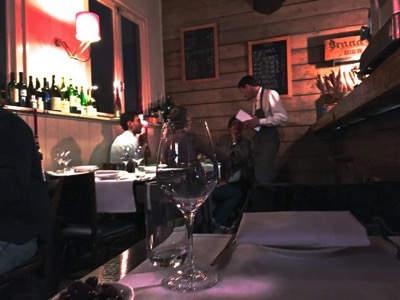
But a carefully considered more-or-less table d'hôte menu, and a wide-ranging wine list. A very serious restaurant, this; the third one we've been to in as many days.
The amuse-guele was, wouldn't you know it, beets, in a pleasant flavored oil, garnished with lovage. Lovage is in the air this week in Amsterdam.
My Companion and I ordered identically. Our first course was salt cod — you'll know by now we never miss an opportunity. But this was not baccalà; it was fresh, not dried, and salted in house.

It was served at room temperature, almost as a sashimi, together with sautéed leeks, whose green leaves had been made into a delicious coulis with a thoughtfully chosen olive oil base enhanced with pistachios.
On top of the whole thing, frisée chiffonade. And the coulis was flavored, just barely detectably, with ash from the charcoal grill on which the leeks had been cooked. This was a very interesting dish, very well balanced, the sweet leeks offsetting the clean, fresh, sea-salty cod. I could have this for breakfast, I think.
Our main course was beef rib-eye, grilled, and served sliced atop an inspired dry grill of thyme — lots of thyme — slices of lemon, and the bottom quarter or so of a whole head of garlic. Hollandse biefstuk, I joked to the patient, engaging waiter, for Dutch beefsteak was a constant presence in the traditional Dutch restaurant repertory I met on my first visits to this country, over forty years ago.

Yes, he said, but with this difference: it's a cut with flavor, not just tenderness; it isn't overcooked; there's no gravy. The beef was Dutch, though; grass fed, and from Gelderland — the Achterhoek, in fact.
With the beef, as a side dish, red cabbage, cooked with chopped hazelnuts and garnished with… lovage. You can't escape it.
Dessert was a simple crème brûlée, nicely flavored, eggy, a suitable modest close to an inventive, rewarding meal. I'd go back any time.
Bandol, Domaine Tempier, 2009: perfect
☛Restaurants visited in 2015 are listed at Eatingday's Restaurants
Back to Marius

Same goes for the menu, always handwritten, usually quickly; always describing a three- or four-course table d'hôte Marktmenu, with a few alternatives on the margin. Tonight,
voorgerecht: Gebakkren rode poon met prei, aardappel en lavassauswhich I'll translate for you course by course.
tussengerecht: Zacht gegaarde koolvis met knolselderij dulse en speklookkingbouillon
hoofdgerecht: Gebraden varkensnek en gestoofde wang met kool, meiraap en grijze cantharellen
dessert: Gepocheerde kweepeer met pistache cake en vanille ijs
My companions chose the voorgerecht to begin with — after the unlisted amuse-gueles of course. Rode poon (Chelidonichthys lucerna) is an Atlantic fish I'm unfamiliar with, a gurnard; it was poached, I'd say, and served with leek, potato, and lovage-flavored jus, and reportedly delicious.
I chose the tussengerecht ("between-course") for my first course. Koolvis (Pollachius virens) is pollock, itself a type of Atlantic cod. (Marius does not make a fetish of carefully distinguishing the various types of fish on its menu; this is simply expected by Dutch diners, who are after all descended from generations of fish-eaters, and like to know what's on the plate.) The fish was slowly cooked, as the menu describes, and served with celeriac and dulse — an edible red seaweed — cooked in a bacon broth.
Now it's no secret that Kees, the chef-owner of Marius, is an old friend, my "Dutch son" in fact, and he'd heard about our dinner New Year's Eve at the home of another chef friend. I'd described the liver-based broth Sander had cooked his mussels in, and the delighted cry Umami! that he'd greeted it with. I don't know if tonight's bacon-based broth on seaweed was a deliberate response or not; probably not — probably coincidental. They have similar tastes, but one's a Rembrandt, the other a Vermeer. One's a free-jazz improviser; the other's an elegant string quartet, part Haydn, part Webern.
But back to the menu: Our hoofdgerecht — chief course — was a delightful winter dish (and it has been cold here): roast pork neck with braised pork cheek, with cabbage, turnips and gray chanterelles. The two meats had been cooked separately, of course, each to exactly the right point. Ditto the vegetables, no one of which prevailed over others — each item in this ragout was as independent, but mindful of its place in the whole, as any bottle in a Morandi still life.
The vanilla ice cream was perfect. Lindsey said so, and she knows ice cream. The pistachio cake tasted exactly like hers, and that's high praise. It was a perfect meal.
Saumur Champigny, Château de Villeneuve, 2001: rich, deep, smooth, substantial, generous
☛Restaurants visited in 2015 are listed at Eatingday's Restaurants
Wednesday, January 6, 2016
Restaurant As
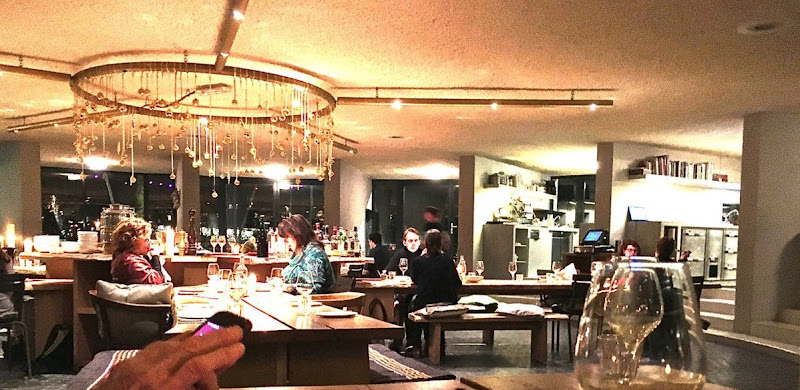
The kitchen, curiously, is outside the building, in a little pavilion of its own. And there Sander Overeinder (who I must mention worked a term at Chez Panisse, many years ago) whips up some truly distinctive and memorable meals.
At table we decided, our two Dutch friends and we, that there are many kinds of chefs: some are like architects, some like painters… Sander is a free-jazz musician, improvising absolutely new things, often with improbable sources and juxtapositions, but on a very solid understanding of the basic principles of coherence and purpose. But let's get to the menu.
The menu here is simple enough: you can have three, four, five, or six courses. The dishes are not described on the menu, which changes daily; the very skilfull waitress explains it for you. As is apparently usual, the fore-course provided two dishes:
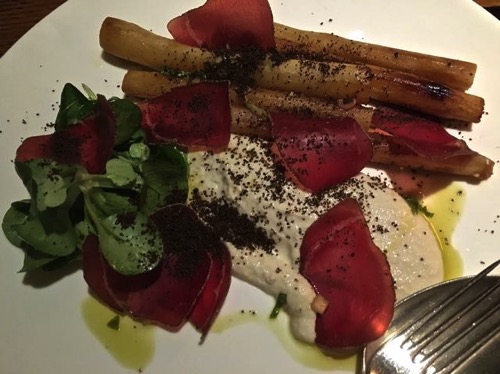

First, salsify sticks with nagelhout, Dutch for "nailboard," which Wikipedia tells me refers to the nail-studded plank these thin slices of beef are stuck to in order to air-dry. A sort of carpaccio jerky, I suppose; very tasty. Under it, chestnut purée, with cream and olive oil; on it, a spray of mâche and a scatter of dark finely crumbed don't-recall-what.
Then raw mackerel filets with roe and pomegranate seeds and onion cups on a bed of kale, with a drizzle of balsamic. Marvelous.
 We're in the Netherlands — Holland, in fact — so beets are inevitable, and our light between-course involved cooked herring with beets and watercress. Steady visitors here will know beets are not to my taste; they always taste like aluminum. But this beet did not; I don't know why. Perhaps it was the proximity of the cooked fish, rich and a little oily. Whatever the case, it was an inspired juxtaposition.
We're in the Netherlands — Holland, in fact — so beets are inevitable, and our light between-course involved cooked herring with beets and watercress. Steady visitors here will know beets are not to my taste; they always taste like aluminum. But this beet did not; I don't know why. Perhaps it was the proximity of the cooked fish, rich and a little oily. Whatever the case, it was an inspired juxtaposition.
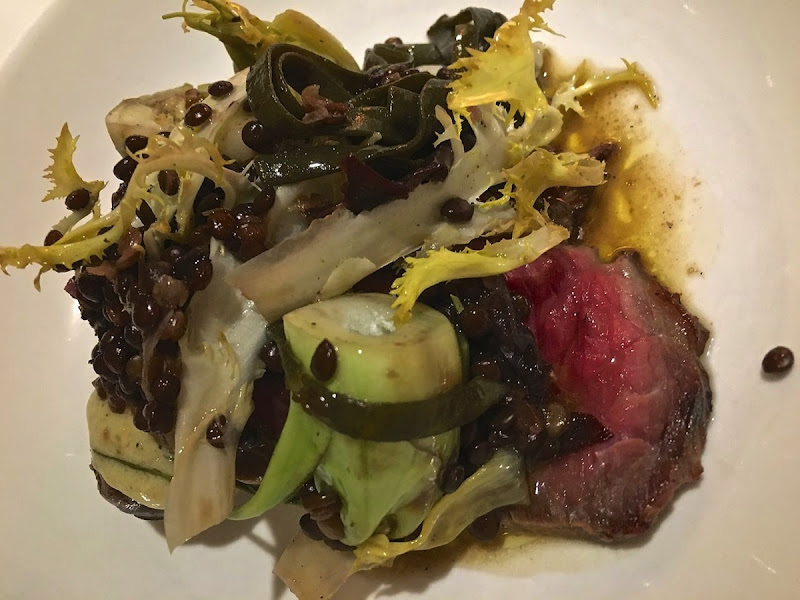
The main course is the hardest of all to describe. Beef, of course, and a piece that cared more about taste and texture than about tenderness. Puntarella, yes, brought in from Italy, and cooked just to soften it a bit — except for the core, normally thrown away, but kept in Sander's frugal kitchen, sliced, steamed until just the right texture. (That's it in the cente, cut side facing up.)
Then too there was a scatter of tiny lentils, because Sander seems always to have beans handy in some form, and uses them as condiments in his complex composed dishes. You don't eat a course like this by deconstructing it; you go at it with knife and fork, taking the whole mix to your palate at once. Some forkfuls will have more meat, or lentils, or puntarella than others; each bite brings out different preponderances, revealing new aspects… oh what a rhapsody…


Desserts, of course. First, poached pear, with a scatter of… wait, what, are these toasted bread crumbs, powdered fine? Not amaretto crumbs? Yes, why not?
And then two delicious sorbets, one a soft caramel, the other — pear and parsnip! Inspired. Chocolate bark to garnish. A stunning end to a magical dinner.
Chablis, Domaine Vincent Dampt, 2014: slow to open, typical, nicely balanced
Cabernet sauvignon, Domaine Richeaume (Provence), "Tradition", 2012: rich and deep, very fine, like Bordeaux used to taste
☛Restaurants visited in 2015 are listed at Eatingday's Restaurants
Tuesday, January 5, 2016
Toscanini
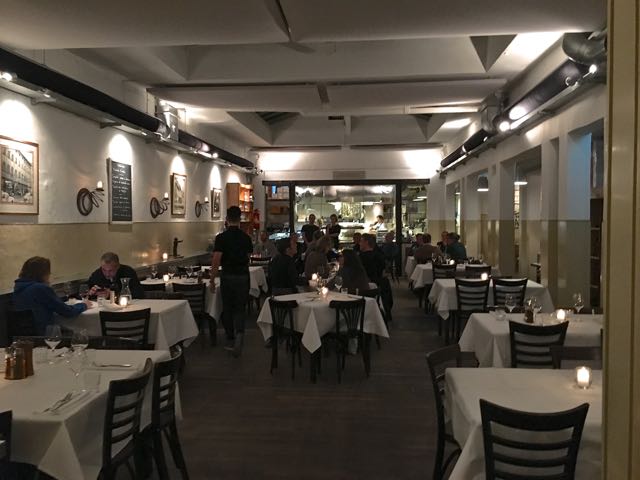
It is also a local favorite of a chef friend, who was with us; I cannot be certain there weren't a few extra slices of garnish on my primo. Probably not, though. This is a generous restaurant.
We ordered from the daily specials listed on the blackboard you may be able to make out on the wall to the left, the second lit object on the wall. (The photo was taken close to midnight; the dining room had been full.)

Our amuse-geule had been baccalà vicentino, salt cod in the Vicenza style, sweet with beautifully reduced onion soffrito taming the cod; and it was delicious. Kees and I went on to the tajarin al tartufo nero: the pasta smooth, liscio — the word is untranslatable, but perfectly appropriate. Yellow with egg, and buttery. And the garnish — well, frankly we prefer white truffles on pasta, my Contessa and I, black truffles need more cooking than the steaming pasta gives them, especially piled this high: but I am not complaining.
On, then, to the secondo: Costata di maiale per due.This turned out to be generously thick slices of smooth-textured, sweet-flavored pork roast, served with a mêlée of leek, clery, onion, and other aromatics in a beautifully semi-reduced glaze.
Dessert: I couldn't resist the offer of panforte: after all, we're still within the Christmas season. I was glad I chose it: figgy, nutty, nicely textured, soft and pleasant.
The flavor, technique, and authenticity of the entire meal — and others remembered from previous visits over the years — puts this firmly among the Hundred Restaurants.
Nebbiolo, Langhe, Elio Altare, 2014:
Again, authentic wines, nicely balanced, fruity, rich, very well made
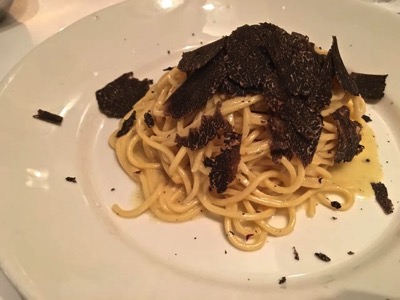


☛Restaurants visited in 2015 are listed at Eatingday's Restaurants
Sunday, January 3, 2016
Steak-frites
There used to be a chain of restaurants called l'Entrecôte. We first met one in the 6th arrondisement in Paris, in the mid-1970s I would say. It served nothing but a green salad dressed with mustard vinaigrette and including walnuts; the entrecôte and its french-fried potatoes, and for dessert a sort of tarte Tatin. There was a joke that instead of a menu the waiter asked two simple questions: saignant ou au point? blanc ou rouge? But the latter, at least, can't be true, because I don't think there was any wine but red.
We subsequently ate at a l'Entrecôte in Amsterdam, at least twice; and I think we once visited one in New York. Then, it seems to me, they fell away from the restaurant scene, which of course had evolved considerably in the meantime.
Tonight, it being Sunday, and New Year's Sunday at that, restaurant options were scarcer than usual here; but a dependable one was available. And on its menu, lo and behold, "Formula Entrecôte." The same green salad, with walnuts, dressed with mustard vinaigrette; the same entrecôte, the same frites. The same mayonnaise for the fries. A similar béarnaise sauce for the meat, though greener than I remembered, and sharper with both tarragon and vinegar — in fact, tarragon-infused vinegar, I think. But tasty.
The L'Entrecôte history is interesting: you can read about it on Wikipedia. I don't know how this restaurant is connected to the original; perhaps it isn't — though, like the original, it's tied to its own French vineyard, and perhaps exists only to move those wines. Down the street, by the way, there's a second restaurant owned by the same woman, and it's called L'Entrecôte et les Dames, or something of the sort.
In any case it was a comfortable, pleasant, nutritious, tasty dinner, unremarkable but very pleasant, and I'd go back any rainy night I was in the mood…
☛Restaurants visited in 2015 are listed at Eatingday's Restaurants
Saturday, January 2, 2016
Marius
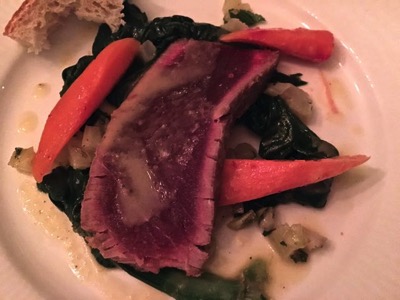 |
 |
 |
We dined at a real favorite. Of course I'm biased: the owner-chef is my Dutch son, who can do no wrong in my book, certainly not in the kitchen. Here's what we had:
Geroosterde tonijn met spinachie, citroen wortel en venkelMarius is a small restaurant, seating maybe thirty; the menu is small, the wine list extensive and well considered. The food is delicious. Did I mention the chef did two year-long stints at Chez Panisse, in Berkeley?
Sautéed tuna with spinach, lemon, carrot, and fennelGebraden Barbarie eend
Sautéed Barbary duckGepocheerde kweepeer met vanilleijs en pistasche
Poached quince with vanilla ice cream and pistachios
The tuna was cooked perfectly and was firm, fresh, and meaty. The duck was also cooked exactly au point and came with delicious cabbage. I don't know when I've had better ice cream, and the quince could have been poached by my own dining companion, so professional, flavorful, and perfectly textured it was.
It is one of the Five Restaurants.
Greco di Tufo, Calafé, 2009;
Cotes de Duras, Domaine Mouthes le Bihan "La Pie Colette," 2012: rich, solid, good finish
☛Restaurants visited in 2015 are listed at Eatingday's Restaurants>


